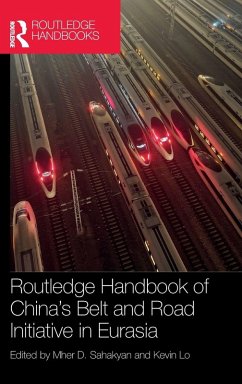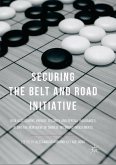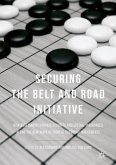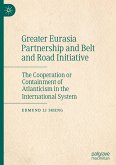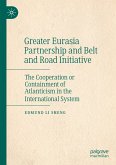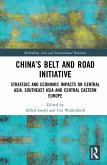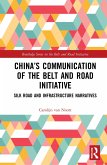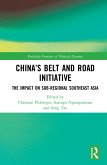Routledge Handbook of China's Belt and Road Initiative in Eurasia
Herausgegeben:Sahakyan, Mher D.; Lo, Kevin
Routledge Handbook of China's Belt and Road Initiative in Eurasia
Herausgegeben:Sahakyan, Mher D.; Lo, Kevin
- Gebundenes Buch
- Merkliste
- Auf die Merkliste
- Bewerten Bewerten
- Teilen
- Produkt teilen
- Produkterinnerung
- Produkterinnerung
This handbook critically analyses and examines the impact of China's Belt and Road Initiative (BRI) geostrategy in Eurasia. Over the last decade, the BRI contributed to China becoming an economic and political superpower, but the Russo-Ukrainian War brought seismic geopolitical and geoeconomic impacts and a new struggle between great powers. Covering the impact of the BRI and the positions of other great, middle, and small powers, the ten parts explain the geopolitical and geoeconomic dynamics along the Silk Road Economic Belt's six major economic corridors, implementing case studies on…mehr
Andere Kunden interessierten sich auch für
![Securing the Belt and Road Initiative Securing the Belt and Road Initiative]() Securing the Belt and Road Initiative65,99 €
Securing the Belt and Road Initiative65,99 €![Securing the Belt and Road Initiative Securing the Belt and Road Initiative]() Securing the Belt and Road Initiative91,99 €
Securing the Belt and Road Initiative91,99 €![Greater Eurasia Partnership and Belt and Road Initiative Greater Eurasia Partnership and Belt and Road Initiative]() Li ShengGreater Eurasia Partnership and Belt and Road Initiative98,99 €
Li ShengGreater Eurasia Partnership and Belt and Road Initiative98,99 €![Greater Eurasia Partnership and Belt and Road Initiative Greater Eurasia Partnership and Belt and Road Initiative]() Li ShengGreater Eurasia Partnership and Belt and Road Initiative98,99 €
Li ShengGreater Eurasia Partnership and Belt and Road Initiative98,99 €![China's Belt and Road Initiative China's Belt and Road Initiative]() China's Belt and Road Initiative168,99 €
China's Belt and Road Initiative168,99 €![China's Communication of the Belt and Road Initiative China's Communication of the Belt and Road Initiative]() Carolijn van NoortChina's Communication of the Belt and Road Initiative167,99 €
Carolijn van NoortChina's Communication of the Belt and Road Initiative167,99 €![China's Belt and Road Initiative China's Belt and Road Initiative]() China's Belt and Road Initiative167,99 €
China's Belt and Road Initiative167,99 €-
-
-
This handbook critically analyses and examines the impact of China's Belt and Road Initiative (BRI) geostrategy in Eurasia. Over the last decade, the BRI contributed to China becoming an economic and political superpower, but the Russo-Ukrainian War brought seismic geopolitical and geoeconomic impacts and a new struggle between great powers. Covering the impact of the BRI and the positions of other great, middle, and small powers, the ten parts explain the geopolitical and geoeconomic dynamics along the Silk Road Economic Belt's six major economic corridors, implementing case studies on Europe, South Caucasus, Central Asia, Russian Far East, Middle East, South Asia, Southeast Asia, and East Asia.
Expert scholars from East, West, North, and South engage with BRI concepts to create a book that will be of interest to policymakers, businesspeople, scholars, and students of area studies, cybersecurity and digitalisation, economics, security studies, the politics of international trade, foreign policy, global governance, and international organisations.
Expert scholars from East, West, North, and South engage with BRI concepts to create a book that will be of interest to policymakers, businesspeople, scholars, and students of area studies, cybersecurity and digitalisation, economics, security studies, the politics of international trade, foreign policy, global governance, and international organisations.
Produktdetails
- Produktdetails
- Verlag: Taylor & Francis; Routledge
- Seitenzahl: 614
- Erscheinungstermin: 15. September 2025
- Englisch
- Abmessung: 240mm x 161mm x 37mm
- Gewicht: 1023g
- ISBN-13: 9781032840956
- ISBN-10: 1032840951
- Artikelnr.: 73390669
- Herstellerkennzeichnung
- Libri GmbH
- Europaallee 1
- 36244 Bad Hersfeld
- gpsr@libri.de
- Verlag: Taylor & Francis; Routledge
- Seitenzahl: 614
- Erscheinungstermin: 15. September 2025
- Englisch
- Abmessung: 240mm x 161mm x 37mm
- Gewicht: 1023g
- ISBN-13: 9781032840956
- ISBN-10: 1032840951
- Artikelnr.: 73390669
- Herstellerkennzeichnung
- Libri GmbH
- Europaallee 1
- 36244 Bad Hersfeld
- gpsr@libri.de
Mher D. Sahakyan is a Fulbright Visiting Scholar at the School of Advanced International Studies of Johns Hopkins University. He is the director of the China-Eurasia Council for Political and Strategic Research in Armenia and the founder of the Eurasian Research on Modern China and Eurasia conference. Mher was an AsiaGlobal Fellow at the Asia Global Institute of the University of Hong Kong (2020/2021 and 2022). He was a 2024 LEWI Visiting Fellow at the David C. Lam Institute for East-West Studies at Hong Kong Baptist University. Mher holds a doctorate in international relations from China's Nanjing University. He is the Editor of Routledge Handbook of Chinese and Eurasian International Relations, China and Eurasian Powers in Multipolar World Order 2.0: Security, Diplomacy, Economy and Cybersecurity, and the cöeditor of China and Eurasia: Rethinking Cooperation and Contradictions in the Era of Changing World Order, published by Routledge in 2024, 2023, and 2021. Kevin Lo is an Associate Professor and Chair of the Department of Geography and Acting Director of the David C. Lam Institute for East-West Studies of Hong Kong Baptist University. He earned his PhD in Geography from the University of Melbourne. He is an Editor¿in¿Chief of the Journal of Asian Energy Studies, an international peer¿reviewed journal dedicated to interdisciplinary research on all aspects of energy studies in Asia. He has won several major competitive grants from the Research Grants Council of Hong Kong and has published in many leading journals, including Global Environmental Change, Political Geography, Renewable and Sustainable Energy Reviews, Energy Policy, Energy for Sustainable Development, Environmental Science & Policy, Cities, Habitat International, and Journal of Rural Studies.
PART I 1. Introduction of the Belt and Road Initiative in the Eurasian
Continent PART II: Silk Road Economic Belt 2. Rebuilding Eurasian
Interconnectivity: China-Central Asia-West Asia Economic Corridor 3.
Evolution of the China-Mongolia-Russia Economic Corridor: Weighing
functionality and rhetoric 4. Explaining the Belt and Road Initiative: A
Case Study of the New Eurasian Land Bridge Economic Corridor 5.
Understanding Bangladesh-China-India-Myanmar Economic Corridor in the Era
of Multipolar World Order 2.0: Perspectives from Bangladesh 6. The
China-Pakistan Economic Corridor in Multipolar World Order 2.0:
Perspectives from India 7. China-Indochina Peninsula Economic Corridor and
Lancang-Mekong Sub-Regional Cooperation in the Era of Multipolar World
Order 2.0 PART III: Digital and Space Silk Roads 8. The security dimension
of the Digital Silk Road: from Netpolitik to Digitalpolitik 9.
Sino-Russian Cybersecurity Cooperation in a Multipolar World Order:
Implications for the Digital Silk Road 10. China's Starry Constellations
with Russia and the Global South: The Space Silk Road Analysed PART IV:
Environmental Governance and Critical Raw Materials 11. The Environmental
Governance of China's Belt and Road Initiative 12. Belt and Road
Initiative's impact on Critical Raw Materials in Eurasia: The case of the
EU PART V: Geopolitical Dynamics 13. Unpacking Chinese Communication about
the Belt and Road Initiative: Moral Realist Project in a World Order 2.0
14. China's Belt and Road Initiative and the US Indo-Pacific Strategy: A
Qualitative Comparative Analysis 15. From Obama to Biden: The United States
Position on BRI under the "China Threat" Narrative PART VI: Central Asia
and the Russian Far East 16. Multipolarity, the Rise of China, and
Kazakhstan's Emergence as a Middle Power 17. The Belt and Road Initiative
in Central Asia: Opportunities and Challenges for Kyrgyzstan and Tajikistan
18. India and China in Central Asia: Neither Rivalry nor Collaboration 19.
Social Innovation Projects in Belt and Road Initiative Countries: Case
Studies of Uzbekistan and China 20. Chinese Investment in the Russian Far
East: Problems and Prospects PART VII: South Caucasus 21. Beyond the
West-Russia Dichotomy: Case Studies on the Hedging Strategies of Armenia,
Azerbaijan, and Georgia 22. The International North-South Transport
Corridor and the Belt and Road Initiative in the South Caucasus PART VIII:
Middle East 23. The Belt and Road Initiative and China-GCC Relations:
Strategic Partnerships in a Multipolar World Order 2.0 24. Prospects for
New Infrastructure Cooperation between China and the Gulf Countries Under
the Belt and Road Initiative 25. Iran's Look East Policy and the Energy
Silk Road: The Energy Partnership of Iran and China 26. Navigating the Silk
Road in Central and Eastern Europe PART IX: Europe 27. Towards a Shared
Future: Upgrade of Strategic Partnership between China and Serbia within
the BRI framework 28. Rethinking Italy-China Cooperation in the Belt and
Road Initiative: The Communication's Impact in the Italian Case Study PART
X: Conclusion 29. Conclusion: A Research and Policy Agenda for the Belt and
Road Initiative
Continent PART II: Silk Road Economic Belt 2. Rebuilding Eurasian
Interconnectivity: China-Central Asia-West Asia Economic Corridor 3.
Evolution of the China-Mongolia-Russia Economic Corridor: Weighing
functionality and rhetoric 4. Explaining the Belt and Road Initiative: A
Case Study of the New Eurasian Land Bridge Economic Corridor 5.
Understanding Bangladesh-China-India-Myanmar Economic Corridor in the Era
of Multipolar World Order 2.0: Perspectives from Bangladesh 6. The
China-Pakistan Economic Corridor in Multipolar World Order 2.0:
Perspectives from India 7. China-Indochina Peninsula Economic Corridor and
Lancang-Mekong Sub-Regional Cooperation in the Era of Multipolar World
Order 2.0 PART III: Digital and Space Silk Roads 8. The security dimension
of the Digital Silk Road: from Netpolitik to Digitalpolitik 9.
Sino-Russian Cybersecurity Cooperation in a Multipolar World Order:
Implications for the Digital Silk Road 10. China's Starry Constellations
with Russia and the Global South: The Space Silk Road Analysed PART IV:
Environmental Governance and Critical Raw Materials 11. The Environmental
Governance of China's Belt and Road Initiative 12. Belt and Road
Initiative's impact on Critical Raw Materials in Eurasia: The case of the
EU PART V: Geopolitical Dynamics 13. Unpacking Chinese Communication about
the Belt and Road Initiative: Moral Realist Project in a World Order 2.0
14. China's Belt and Road Initiative and the US Indo-Pacific Strategy: A
Qualitative Comparative Analysis 15. From Obama to Biden: The United States
Position on BRI under the "China Threat" Narrative PART VI: Central Asia
and the Russian Far East 16. Multipolarity, the Rise of China, and
Kazakhstan's Emergence as a Middle Power 17. The Belt and Road Initiative
in Central Asia: Opportunities and Challenges for Kyrgyzstan and Tajikistan
18. India and China in Central Asia: Neither Rivalry nor Collaboration 19.
Social Innovation Projects in Belt and Road Initiative Countries: Case
Studies of Uzbekistan and China 20. Chinese Investment in the Russian Far
East: Problems and Prospects PART VII: South Caucasus 21. Beyond the
West-Russia Dichotomy: Case Studies on the Hedging Strategies of Armenia,
Azerbaijan, and Georgia 22. The International North-South Transport
Corridor and the Belt and Road Initiative in the South Caucasus PART VIII:
Middle East 23. The Belt and Road Initiative and China-GCC Relations:
Strategic Partnerships in a Multipolar World Order 2.0 24. Prospects for
New Infrastructure Cooperation between China and the Gulf Countries Under
the Belt and Road Initiative 25. Iran's Look East Policy and the Energy
Silk Road: The Energy Partnership of Iran and China 26. Navigating the Silk
Road in Central and Eastern Europe PART IX: Europe 27. Towards a Shared
Future: Upgrade of Strategic Partnership between China and Serbia within
the BRI framework 28. Rethinking Italy-China Cooperation in the Belt and
Road Initiative: The Communication's Impact in the Italian Case Study PART
X: Conclusion 29. Conclusion: A Research and Policy Agenda for the Belt and
Road Initiative
PART I 1. Introduction of the Belt and Road Initiative in the Eurasian
Continent PART II: Silk Road Economic Belt 2. Rebuilding Eurasian
Interconnectivity: China-Central Asia-West Asia Economic Corridor 3.
Evolution of the China-Mongolia-Russia Economic Corridor: Weighing
functionality and rhetoric 4. Explaining the Belt and Road Initiative: A
Case Study of the New Eurasian Land Bridge Economic Corridor 5.
Understanding Bangladesh-China-India-Myanmar Economic Corridor in the Era
of Multipolar World Order 2.0: Perspectives from Bangladesh 6. The
China-Pakistan Economic Corridor in Multipolar World Order 2.0:
Perspectives from India 7. China-Indochina Peninsula Economic Corridor and
Lancang-Mekong Sub-Regional Cooperation in the Era of Multipolar World
Order 2.0 PART III: Digital and Space Silk Roads 8. The security dimension
of the Digital Silk Road: from Netpolitik to Digitalpolitik 9.
Sino-Russian Cybersecurity Cooperation in a Multipolar World Order:
Implications for the Digital Silk Road 10. China's Starry Constellations
with Russia and the Global South: The Space Silk Road Analysed PART IV:
Environmental Governance and Critical Raw Materials 11. The Environmental
Governance of China's Belt and Road Initiative 12. Belt and Road
Initiative's impact on Critical Raw Materials in Eurasia: The case of the
EU PART V: Geopolitical Dynamics 13. Unpacking Chinese Communication about
the Belt and Road Initiative: Moral Realist Project in a World Order 2.0
14. China's Belt and Road Initiative and the US Indo-Pacific Strategy: A
Qualitative Comparative Analysis 15. From Obama to Biden: The United States
Position on BRI under the "China Threat" Narrative PART VI: Central Asia
and the Russian Far East 16. Multipolarity, the Rise of China, and
Kazakhstan's Emergence as a Middle Power 17. The Belt and Road Initiative
in Central Asia: Opportunities and Challenges for Kyrgyzstan and Tajikistan
18. India and China in Central Asia: Neither Rivalry nor Collaboration 19.
Social Innovation Projects in Belt and Road Initiative Countries: Case
Studies of Uzbekistan and China 20. Chinese Investment in the Russian Far
East: Problems and Prospects PART VII: South Caucasus 21. Beyond the
West-Russia Dichotomy: Case Studies on the Hedging Strategies of Armenia,
Azerbaijan, and Georgia 22. The International North-South Transport
Corridor and the Belt and Road Initiative in the South Caucasus PART VIII:
Middle East 23. The Belt and Road Initiative and China-GCC Relations:
Strategic Partnerships in a Multipolar World Order 2.0 24. Prospects for
New Infrastructure Cooperation between China and the Gulf Countries Under
the Belt and Road Initiative 25. Iran's Look East Policy and the Energy
Silk Road: The Energy Partnership of Iran and China 26. Navigating the Silk
Road in Central and Eastern Europe PART IX: Europe 27. Towards a Shared
Future: Upgrade of Strategic Partnership between China and Serbia within
the BRI framework 28. Rethinking Italy-China Cooperation in the Belt and
Road Initiative: The Communication's Impact in the Italian Case Study PART
X: Conclusion 29. Conclusion: A Research and Policy Agenda for the Belt and
Road Initiative
Continent PART II: Silk Road Economic Belt 2. Rebuilding Eurasian
Interconnectivity: China-Central Asia-West Asia Economic Corridor 3.
Evolution of the China-Mongolia-Russia Economic Corridor: Weighing
functionality and rhetoric 4. Explaining the Belt and Road Initiative: A
Case Study of the New Eurasian Land Bridge Economic Corridor 5.
Understanding Bangladesh-China-India-Myanmar Economic Corridor in the Era
of Multipolar World Order 2.0: Perspectives from Bangladesh 6. The
China-Pakistan Economic Corridor in Multipolar World Order 2.0:
Perspectives from India 7. China-Indochina Peninsula Economic Corridor and
Lancang-Mekong Sub-Regional Cooperation in the Era of Multipolar World
Order 2.0 PART III: Digital and Space Silk Roads 8. The security dimension
of the Digital Silk Road: from Netpolitik to Digitalpolitik 9.
Sino-Russian Cybersecurity Cooperation in a Multipolar World Order:
Implications for the Digital Silk Road 10. China's Starry Constellations
with Russia and the Global South: The Space Silk Road Analysed PART IV:
Environmental Governance and Critical Raw Materials 11. The Environmental
Governance of China's Belt and Road Initiative 12. Belt and Road
Initiative's impact on Critical Raw Materials in Eurasia: The case of the
EU PART V: Geopolitical Dynamics 13. Unpacking Chinese Communication about
the Belt and Road Initiative: Moral Realist Project in a World Order 2.0
14. China's Belt and Road Initiative and the US Indo-Pacific Strategy: A
Qualitative Comparative Analysis 15. From Obama to Biden: The United States
Position on BRI under the "China Threat" Narrative PART VI: Central Asia
and the Russian Far East 16. Multipolarity, the Rise of China, and
Kazakhstan's Emergence as a Middle Power 17. The Belt and Road Initiative
in Central Asia: Opportunities and Challenges for Kyrgyzstan and Tajikistan
18. India and China in Central Asia: Neither Rivalry nor Collaboration 19.
Social Innovation Projects in Belt and Road Initiative Countries: Case
Studies of Uzbekistan and China 20. Chinese Investment in the Russian Far
East: Problems and Prospects PART VII: South Caucasus 21. Beyond the
West-Russia Dichotomy: Case Studies on the Hedging Strategies of Armenia,
Azerbaijan, and Georgia 22. The International North-South Transport
Corridor and the Belt and Road Initiative in the South Caucasus PART VIII:
Middle East 23. The Belt and Road Initiative and China-GCC Relations:
Strategic Partnerships in a Multipolar World Order 2.0 24. Prospects for
New Infrastructure Cooperation between China and the Gulf Countries Under
the Belt and Road Initiative 25. Iran's Look East Policy and the Energy
Silk Road: The Energy Partnership of Iran and China 26. Navigating the Silk
Road in Central and Eastern Europe PART IX: Europe 27. Towards a Shared
Future: Upgrade of Strategic Partnership between China and Serbia within
the BRI framework 28. Rethinking Italy-China Cooperation in the Belt and
Road Initiative: The Communication's Impact in the Italian Case Study PART
X: Conclusion 29. Conclusion: A Research and Policy Agenda for the Belt and
Road Initiative

